This does not deal with the Manasquan River per se... but we do have some sea runs in the 'squan:
Sea-Run Brown Trout Fishing in Newfoundland
By Paul Smith
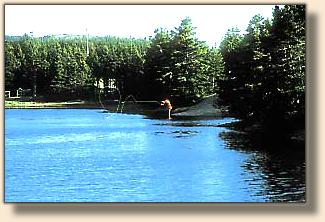 I live within 5 to 15 minutes driving from some of the best sea-run brown trout water in the world. Spaniard’s Bay, a quiet community of about 5000 people is located on the North side of Conception Bay, Newfoundland, a mere hour’s drive North America’s oldest city, St. John’s. It may be a little too convenient and tempting when you can see the ocean from your bathroom window. Once last spring I woke at two in the morning for a call of nature, looked out at the full April moon beaming down on a perfect low tide, and just couldn’t resist. I quickly dressed, grabbed my gear, and within minutes I was to my waist in tidal sea-trout water.That night turned out to be one of the best night fishing experiences I’ve ever had. It was cold and about every 10 casts or so I would have to clean the ice out of my rod guides, but by daylight I had landed 13 sea-run browns ranging between two and four pounds. All were hooked on dead drifted nymphs, and I had to squint to see my line in the moonlight, detecting the unnatural motion that signals a subtle and sneaky brown trout hit. Browns are funny like that. Sometimes they hit like a freight train and almost yank the rod right out of your hands. Other times, the free drifting nymph just stops in the current. It makes you wonder how many fish you miss on black or windy nights.I went back home shortly after daylight, cold but contented. I sat in my kitchen with a coffee, watching the sunrise over the ocean. My wife called out from the bedroom, "Where are you going this early in the morning?"
I live within 5 to 15 minutes driving from some of the best sea-run brown trout water in the world. Spaniard’s Bay, a quiet community of about 5000 people is located on the North side of Conception Bay, Newfoundland, a mere hour’s drive North America’s oldest city, St. John’s. It may be a little too convenient and tempting when you can see the ocean from your bathroom window. Once last spring I woke at two in the morning for a call of nature, looked out at the full April moon beaming down on a perfect low tide, and just couldn’t resist. I quickly dressed, grabbed my gear, and within minutes I was to my waist in tidal sea-trout water.That night turned out to be one of the best night fishing experiences I’ve ever had. It was cold and about every 10 casts or so I would have to clean the ice out of my rod guides, but by daylight I had landed 13 sea-run browns ranging between two and four pounds. All were hooked on dead drifted nymphs, and I had to squint to see my line in the moonlight, detecting the unnatural motion that signals a subtle and sneaky brown trout hit. Browns are funny like that. Sometimes they hit like a freight train and almost yank the rod right out of your hands. Other times, the free drifting nymph just stops in the current. It makes you wonder how many fish you miss on black or windy nights.I went back home shortly after daylight, cold but contented. I sat in my kitchen with a coffee, watching the sunrise over the ocean. My wife called out from the bedroom, "Where are you going this early in the morning?"
Origins
Newfoundland was the first part of Canada to be stocked with brown trout. According to a newspaper clipping posted on the wall of the Heart’s Content Cable Station Museum, ships involved in laying the first Trans Atlantic Cable carried trout in live wells for food on the voyage, and uneaten fish from these were dumped near Heart’s Content in Trinity Bay about 1866. But, in addition, there was also an organized and systematic stocking of brown trout. It has an interesting history.In 1864, "The St. John’s Game Fish Protection Society" was formed. The founding members consisted of the socially and politically elite of St. John’s, including the Prime Minister of the day, Sir Robert Bond. In 1887, this fledging society formed the first privatized fishery in Newfoundland. For 25 cents per year they leased Long Pond, which is now within the city limits of St. John’s, and built a fish hatchery on its inflow. In 1888, The St. John’s Game Fish Protection Society arranged, and privately paid for, the shipment of 118,000 Loch Leven brown trout eggs from Scotland to the Long Pond hatchery. As part of the lease arrangement, 10,000 fry from the hatchery were given over to the Newfoundland government each year for distribution throughout the island.
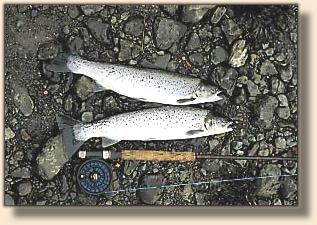 Not all the trout brought over were Loch Levens. In the 1890’s, Robert Brehn, who was born in Germany, became a member of the society and initiated the introduction of German brown trout. English browns were brought over as well. In fact, there are two ponds (Clements and Lees) just north-east of St. John’s, that hold pure strains of English browns from this era.Many Newfoundlanders refer to our trout mistakenly as "German" browns. This originated from American troops stationed in Newfoundland during World War II, who were used to referring to browns as "German", and the name stuck. But what we probably have today in Newfoundland could best be described as "Newfoundland browns". Evidence seems to indicate that, apart from a few isolated pockets, the various strains have interbred over the past 100 years and are now difficult to distinguish.Today the average size of sea-run browns caught in Newfoundland is between one and three pounds, but fish up to 10 pounds are not at all uncommon and, every year, fish in the 10 to 20 pound range are caught. The record is a whopping 28 pounds. This is clearly a world class fishery. Only rivers such as the Rio Grande in the United States, the Rio Gallegos in South America, and the Ems in Sweden consistently produce fish this large.
Not all the trout brought over were Loch Levens. In the 1890’s, Robert Brehn, who was born in Germany, became a member of the society and initiated the introduction of German brown trout. English browns were brought over as well. In fact, there are two ponds (Clements and Lees) just north-east of St. John’s, that hold pure strains of English browns from this era.Many Newfoundlanders refer to our trout mistakenly as "German" browns. This originated from American troops stationed in Newfoundland during World War II, who were used to referring to browns as "German", and the name stuck. But what we probably have today in Newfoundland could best be described as "Newfoundland browns". Evidence seems to indicate that, apart from a few isolated pockets, the various strains have interbred over the past 100 years and are now difficult to distinguish.Today the average size of sea-run browns caught in Newfoundland is between one and three pounds, but fish up to 10 pounds are not at all uncommon and, every year, fish in the 10 to 20 pound range are caught. The record is a whopping 28 pounds. This is clearly a world class fishery. Only rivers such as the Rio Grande in the United States, the Rio Gallegos in South America, and the Ems in Sweden consistently produce fish this large.
The Fish
Fly fishing for sea-run browns is relatively new in Newfoundland, and until recently, there was little available information about them. However, thanks to the research of Ian Gall and Scot Chafe, this is changing.
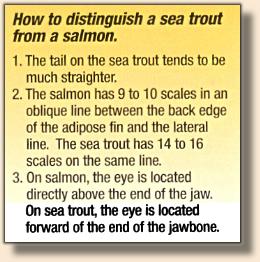 The life cycle of the sea-run brown trout is somewhat similar to that of its cousin, the Atlantic salmon, but we do know that there are significant variations in the life cycles of stocks from river to river, and even between individual fish of the same stock.
The life cycle of the sea-run brown trout is somewhat similar to that of its cousin, the Atlantic salmon, but we do know that there are significant variations in the life cycles of stocks from river to river, and even between individual fish of the same stock.
For instance, unlike salmon, not all browns in a particular river migrate to sea. Some stay in fresh water all year round. Research has shown that three times as many females as males are sea-going. This might be due to the energy requirement associated with egg production and the attraction of the protein rich ocean environment.Sea-run browns have much more complex and flexible migration patterns than salmon. Not only does the timing of runs vary from river to river, there is also considerable variation within individual rivers. Fish will move in and out from February to November. Some individuals will move to the salt and stay there for several years and may not return to their natal rivers. Many do not venture into the open ocean, but hang around the estuaries and sheltered bays. While this can be frustrating at times, it makes for interesting and varied fishing.Fresh-run brown trout have a distinctively different appearance from non-migratory trout and from migratory trout that have been in fresh water for some time. When brown trout go to sea they tend to lose their distinctive spotting, develop scales, and take on an overall silvery appearance. They also tend to put on weight and become much chunkier than their stay-at-home cousins. In fact, sea trout look very much like Atlantic salmon and, to the untrained eye, are difficult to distinguish. This can be a problem because salmon and sea trout are often located in the same river at the same time, but fall under different fishing regulations. Being capable of distinguishing these fish is important if you choose to fish in Atlantic salmon scheduled waters for sea trout. There are hefty fines for taking salmon without proper tags and license.
Equipment
Typical tackle for sea-run browns is an 8 or 9 weight, 9 to 10 foot rod, with a matching floating line. You can use a sink- tip line for nymphing if you wish, but it isn’t really necessary. To fish many of the hot spots, it’s necessary to roll cast at least 50 feet of line. Alternatively, you can use a small boat or canoe to obtain sufficient room for a back cast. Generally, long leaders are best (sea trout are very wary), although you have to balance this against getting the leader to turn over, especially when roll casting.Fly selection depends on where and when you are fishing. It’s always best to consult the locals. This is a relatively new fishery and the best flies are locally tied and not widely available commercially. You may find some effective patterns in local stores, but you can’t count on it. However, if you visit Spaniard’s Bay, check out Paul Kearley’s Fly Shop. He fishes sea trout himself and stocks all the popular patterns.
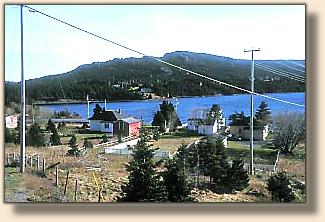 There is plenty of room for experi-mentation with your own ties. Just about every year a new killer fly comes on the scene. The best patterns tend to be very simple, but the fish are very fussy about size and colour. What is interesting about sea trout is that they seem to learn the patterns. A new fly will be deadly for a year or so, but, with time, its effectiveness will fade.
There is plenty of room for experi-mentation with your own ties. Just about every year a new killer fly comes on the scene. The best patterns tend to be very simple, but the fish are very fussy about size and colour. What is interesting about sea trout is that they seem to learn the patterns. A new fly will be deadly for a year or so, but, with time, its effectiveness will fade.
Techniques
Sea trout fishing in Newfoundland offers a variety of options. You can fish in a tidal estuary in the middle of a community or in a tumbling, boulder-strewn river in relative solitude. You can nymph fish on a cold spring night or you can dry fly fish on a warm summer day. I have even had success fishing in a snowstorm.
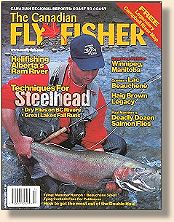 If there are fish in a particular spot, you will usually see them finning the surface from time to time. This is true even in winter. But if you’re new to the area, you can best locate fish by watching the locals. They’re the experts, so watch them closely and don’t be afraid to ask questions. Newfoundlanders are known world-wide for their hospitality, and they will typically point you in the right direction. You also have the option of hiring a local guide. Remember, though, that brown trout are renowned for their wariness, and those in Newfoundland are no exception. Catching them requires dedication, patience, attention to detail, and a tolerance for harsh weather conditions.
If there are fish in a particular spot, you will usually see them finning the surface from time to time. This is true even in winter. But if you’re new to the area, you can best locate fish by watching the locals. They’re the experts, so watch them closely and don’t be afraid to ask questions. Newfoundlanders are known world-wide for their hospitality, and they will typically point you in the right direction. You also have the option of hiring a local guide. Remember, though, that brown trout are renowned for their wariness, and those in Newfoundland are no exception. Catching them requires dedication, patience, attention to detail, and a tolerance for harsh weather conditions.
Night Fishing
Brown trout are nocturnal and can be effectively fished at night. Nymphs are used for this and are allowed to drift along in the tide until you see or feel a strike. You need sharp eyes because you don’t always feel the strikes. In my experience, only about 50 percent of strikes are felt. The nymphs used are very simple. Tied on size #8 - #4 nymph hooks, they consist of a silver tag and a chenille body (yellow, red, pink, etc) with a very short sparse hackle and a chenille head usually coloured different than the body. If you’re tying your own, don’t be afraid to experiment. Also, remember to dress warmly and take a flashlight. Night fishing is usually best in late winter and early spring. ~ Paul Smith


 The life cycle of the sea-run brown trout is somewhat similar to that of its cousin, the Atlantic salmon, but we do know that there are significant variations in the life cycles of stocks from river to river, and even between individual fish of the same stock.
The life cycle of the sea-run brown trout is somewhat similar to that of its cousin, the Atlantic salmon, but we do know that there are significant variations in the life cycles of stocks from river to river, and even between individual fish of the same stock.

No comments:
Post a Comment